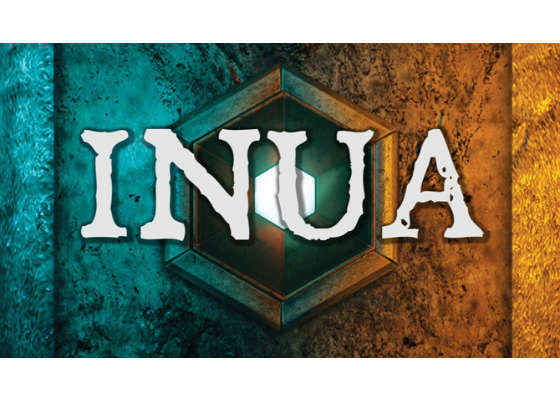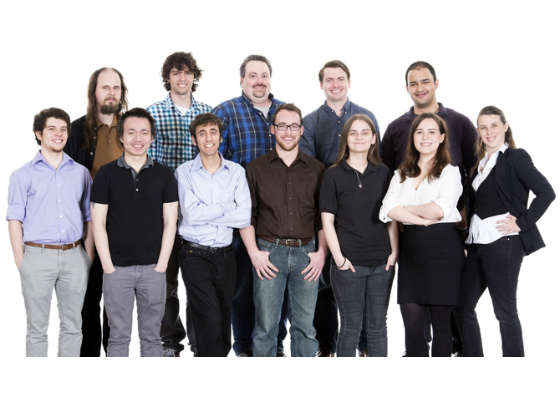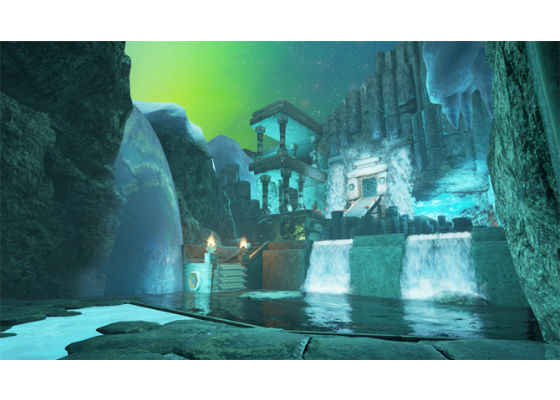Intel Continues Quest for New Talent, as SMU Guildhall Dazzles With Fire and Ice

Imagine that you are Kaya, a young woman of the northern tribe. Your people worship the nature goddess but, having fallen out of favor with this celestial being, are now denied the sacred knowledge of fire and ice. Your task: traverse an ancient temple to learn the power of these elemental forces and show your people the ways of balance. You achieve this by reaching the highest terrace, the Elemental Temple.
This is Inua, an action-packed, first-person 3D puzzler in which players use ice and fire to manipulate their environment and confound enemies in order to progress through a mysterious sacred structure. Developed by a dedicated team of students at Southern Methodist University (SMU) Guildhall, Inua recently scooped up First Place for Best Visuals at the 2016 Intel® University Games Showcase (IUGS), highlighting the awe-inspiring possibilities when developers combine state-of-the-art hardware, stunning graphics, and some amazing creative talent.
This article details the challenging yet rewarding journey that Inua’s developers faced from concept to completion, and, eventually, the winner’s podium.
The Game’s the Thing
Held in conjunction with the Game Developers Conference (GDC), the IUGS invites representatives from the top ten academic game-developer programs to present their feats of magic to an enthusiastic audience consisting of industry professionals, fellow students, the press, and media influencers. The third annual showcase, in 2016, saw schools including Carnegie Mellon University, Drexel University, and UC Santa Cruz, among others, compete for $35,000 in hardware prizes. A panel of judges consisting of game industry luminaries picked the winners.
Led by game producer Matt Worrell, SMU Guildhall was looking to build on past triumphs, including two top-prize wins at the first IUGS in 2014. “As a team, we had several goals with Inua, but competing in the Intel University Games Showcase was our top objective,” said Worrell.
Located in Plano, Texas, SMU Guildhall features a leading-edge digital game-development program, offering specializations in art creation, level design, production, and programming. Established in 2003, the school has seen over 600 students graduate, with alumni working at more than 250 video game studios around the world.
Most years, SMU Guildhall has class sizes ranging from 40 to 50 students. But Worrell’s cohort had only twelve students, which persuaded him to augment the core group with artists from earlier cohorts. Rounding out the SMU Guildhall team was a set of talented programmers, designers, and an audio developer, together with lead designer Jon Clark. “We were Batman and Robin, me as producer and Jon as game designer,” joked Worrell.
Inua team members: (top, from left) Brian Rust, David Gautier, Jason Leary, Matt Worrell, Michael Crawford (front row, from left) Trevor Youngblood, Hoang Nguyen, Evan Kohn, Jon Clark, Laura Brothers, Taylor Smith and Amanda East.
With the team in place and ideas quickly gelling, it was time to choose a name for the group. After much discussion, they settled on ‘Betrayal Games’, taken from the board game Betrayal at House on the Hill, which the team played during lunch hours. The serious work could now start.
Growing an Idea Organically
Coming up with the game concept was the critical first step, and definitely a team effort. Every person, regardless of role, had to pitch their best idea to the team, even if they didn’t have a fully-formed proposal. Worrell said that this was to ensure that everybody felt comfortable sharing ideas and raising issues throughout the development process. As it turns out, it was Worrell’s idea that won the day, though the game he pitched was very different to what Inua ultimately became.
“My initial idea would have forced a huge animation budget that we simply couldn't afford,” recalled Worrell. But a few of the core ideas were strong enough to survive. To begin, the designers liked the idea of creating fun, interesting puzzles. In addition, everybody on the team loved the notion of incorporating the power of nature into the story narrative. And, finally, the team wanted to imbue Inua with a rich organic environment.
The Ice Trail, showcasing Inua’s amazing graphical environment.
Unlike many first-person puzzle challenges that situate players in clean, lab-like settings, with flat walls and easy-to-spot visual cues, Inua offers a deeply textured and visually complex environment full of rocks, water, ice and fire. Intricate and elaborate details, as fashioned by nature, are everywhere. With these core ideas in hand, the SMU Guildhall team readjusted to match available resources, eventually coming up with a game that resonated with everybody.
To reach the desired level of realism, the team looked to real-world examples for inspiration, focusing on dramatic environments such as Iceland, Alaska, Ireland, and Scotland. The team also became captivated by the otherworldly appearance of basalt columns, and cave rock formations that inherently project the power of nature.
At this point, the team worked together to develop a prototype to prove Inua’s technology and art style, ensuring that everyone shared a rock-solid, unified vision. With pre-production formally beginning in fall 2014, and principal development commencing the following spring, Worrell recalls experimenting with a lot of different ideas. “We didn't really settle on any one idea until late December, but when we did, we made sure that the design would present well at IUGS.”
When a good idea would materialize, the team went through a series of trials to check whether it fit the core ideas of the game, in addition to the time- and budget-constraints. This helped flesh out the mechanism to locate cues within the environment to help players navigate, and ultimately succeed at, the game. “We had to find a way to teach players about certain abilities throughout the game,” explained Worrell. “And we had to do that in a fun way.”
The process, however, wasn’t perfect. In one notable instance, the team had developed a major gear system showing the balance between the natural and the mechanical world, and how Kaya’s people could move from spiritually aligned to engineered systems. But after developing an entire level of gears and moving platforms, the team found that it simply didn’t fit thematically. Even though it was late in production, the decision was made to leave the level out.
Crafting the Product
Worrell describes the SMU Guildhall program as intense, and designed to prepare students for industry. To that end, team members had to commit to 15 hours of core development work together each week, in addition to their regular studies and exams. Not surprisingly, extra work was often necessary when approaching deadlines.
Early on, the team selected Unreal* Engine 4 as the development platform, both for its power and its prominence within the gaming industry. “The engine is fantastic,” enthused Worrell. “We knew we wanted to make a complex, beautiful environment, and Unreal Engine 4’s physics-based Material Editor was ideal for that.”
The SMU Guildhall team was equally impressed with how quickly members were able to come up to speed with the tool.
“Unreal Engine 4 is basically made for everybody,” noted Worrell, pointing to the easy-to-useBlueprints system, which allows visual scripting and live debugging without the need for C++ code. Similarities with the Unreal Development Kit (UDK), which is the free edition of Unreal Engine 3, further helped smooth the transition. Likewise, the new Material Editor, enhanced with an expanded set of Gizmos, presented few unexpected issues.
Most importantly, Unreal Engine 4 allowed each team member to work to his or her particular strengths. For example, artists were able to focus on creating lighting and assets; designers could create systems; and programmers were able to integrate everything with C++ code.
There was one catch, though. Unreal Engine 4 was constantly being enhanced and updated while Inua was in development. According to Worrell, the team had to adjust to seven major updates to the system over the 18 weeks of principal development, and many more minor upgrades. This led to some challenging situations.
For instance, the team would create a system for physics-based water using Blueprints, and then, a couple of weeks later, a new update would become available with the system built-in and implemented in the engine in a significantly better way. In another case, the team had to decide between creating either transparent or bright, reflecting water; they chose the former.
A later edition of the engine seamlessly provided both options. The team also had a number of issues with lighting: early on, the engine only supported one dynamic light. That changed in mid-development as well. “It was a give-and-take, developing using an engine that was itself in development,” explained Worrell. “We had to really be fluid in how we managed the process.”
Part of the solution involved adopting an agile and rapid prototyping methodology that allowed player test-results and new ideas to be quickly incorporated. This approach was particularly helpful for solving several gameplay issues. For example, at various points in the game, test players sometimes felt completely lost. “They didn’t know where they could use their powers, or how they could progress,” explained Worrell. To help players along without giving too much away, the team added something called a “spirit trail,” which is a floating particle that hovers around items that offer interaction.
At the very beginning, when players are learning the game for the first time, the spirit trail literally circles items with which players need to interact. Later in the game, however, the spirit trail simply leads players into a room, and lets them figure things out for themselves. “Through trial-and-error, we learned which play elements worked and which did not,” noted Worrell.
Teaming with Intel for Success
Intel technology played a crucial role in the success of Inua. First and foremost, the SMU Guildhall team relied heavily on a powerful set of Intel® Swarm servers to push iterations out quickly, enhancing the benefits of rapid prototyping. “We had heard horror stories that people sometimes stopped working because they didn’t want to touch their computer and risk crashing a build,” noted Worrell. Not so with the Intel® Swarm servers. The team was able to push builds within an hour, early in the development cycle. Even later, with a much bigger game to build, the process only took two or three hours.
Inua presentation at the 2016 IUGS: (from left to right) Taylor Smith, Jon Clark, and Matt Worrell.
The team also benefited from using an Intel-supplied laptop computer, offered to every team for testing as part of the competition. Pushing Unreal Engine 4 to the max, Worrell quietly confessed that the team had spent little time optimizing.
When it came time to test on the laptop, the team didn’t know what to expect. “We were shocked,” admitted Worrell. In fact, the team didn’t need to create a separate build or make any adjustments to have the game work on the Intel machine. “It was able to handle whatever we threw at it,” Worrell went on. “And that’s partly because of the awesome integrated Intel graphics in the laptop."
“The Intel folks were a great group of people who answered all our questions quickly,” said Worrell. “There were so many amazing games in the competition, and thanks to all the organization and help, we were able to offer a smashing presentation.”
Looking Forward
For SMU Guildhall, winning the Best Visuals category was incredibly rewarding. “Visuals are what we hung our hat on, and so that meant a lot to the team,” said Worrell. The future of Inua is less certain, though, since much of the team has already moved on to new projects. Worrell has reason to be optimistic, however. Two games made at SMU Guildhall last fall–Gravitas (a game on which Worrell also worked) and Scrapped–have both been greenlit by the Steam* online gaming community, and will be available in the Steam Community Market. Worrell hopes to be able to do something similar with Inua.
Another option is to port Inua to one or more console platforms, such as Playstation* or Xbox*–the game plays very well using a console controller, according to Worrell. The good news is that SMU Guildhall makes it easy for team members to monetize their work. As long as the entire team agrees, the university presents no obstacles to the team taking over the intellectual property. “Guildhall wants you to succeed and do well with your game,” explained Worrell. “It's something that we might choose to do with Inua.” Launching aKickstarter campaign is another option that Worrell might consider.
In the meantime, Worrell encourages people to keep an eye on SMU Guildhall. “There are super-talented and creative people there, producing some very unique and awesome games.”
SIDEBAR
Tips From the Inua Team for Creating an Award-Winning Game
- Engage all members of your team from the start to encourage idea-sharing and prompt issue resolution.
- Choose a distinctive feature (an organically-complex visual environment in the case of Inua) to differentiate your game from others.
- Ensure that new ideas integrate well with the core of your game, and be prepared to cut content that does not fit thematically.
- Choose a suitable development environment to match the needs of your game (Unreal Engine 4 forInua), but understand that environments are dynamic and get updated with new capabilities regularly.
- Adopt a rapid development methodology (Inua builds ran on Intel Swarm servers for speedy turnaround) and test frequently to solve any gameplay issues early.
For more such intel resources and tools from Intel on Game, please visit the Intel® Game Developer Zone
Source: https://software.intel.com/en-us/articles/intel-continues-quest-for-new-talent-as-smu-guildhall-dazzles-with-fire-and-ice







